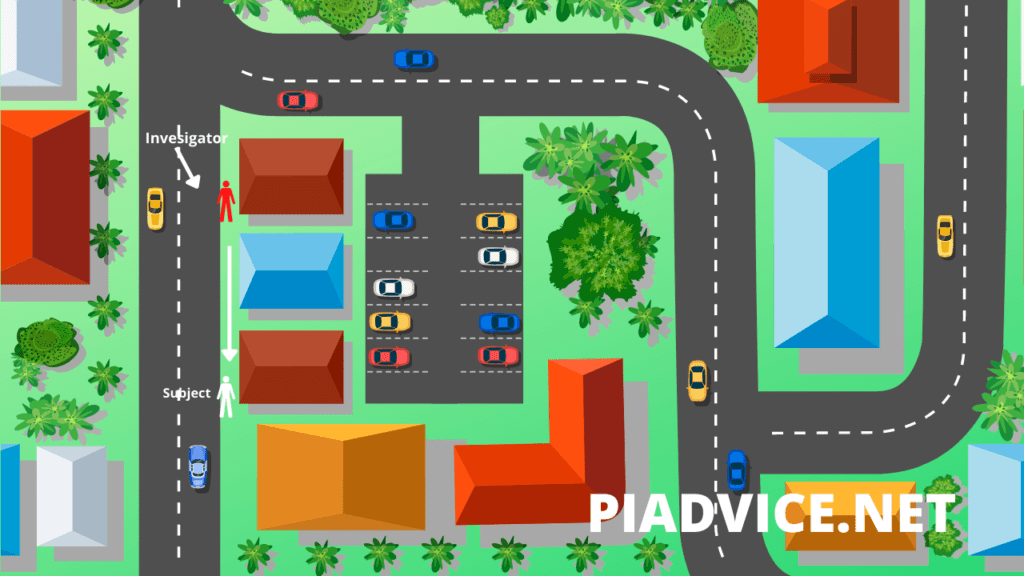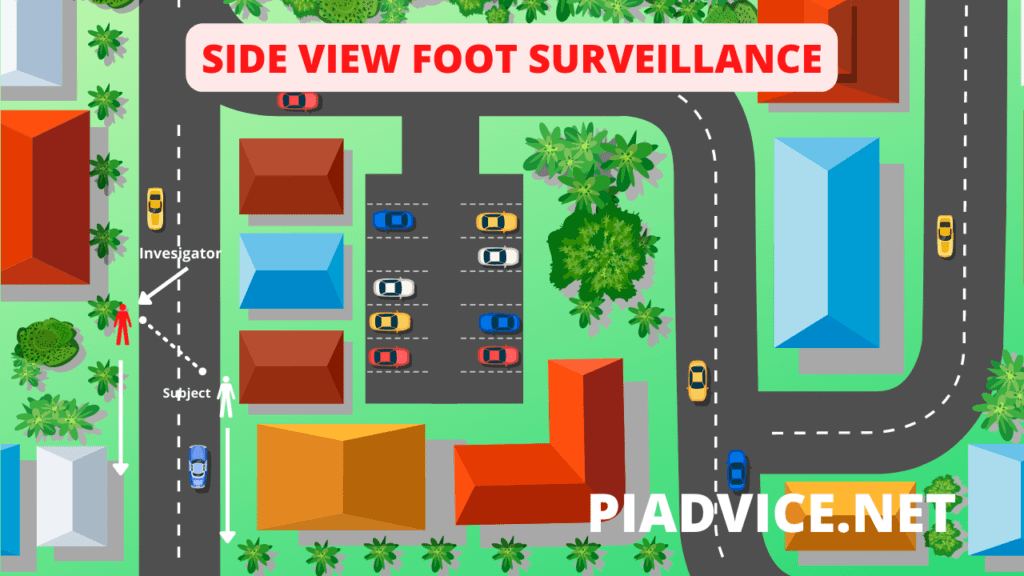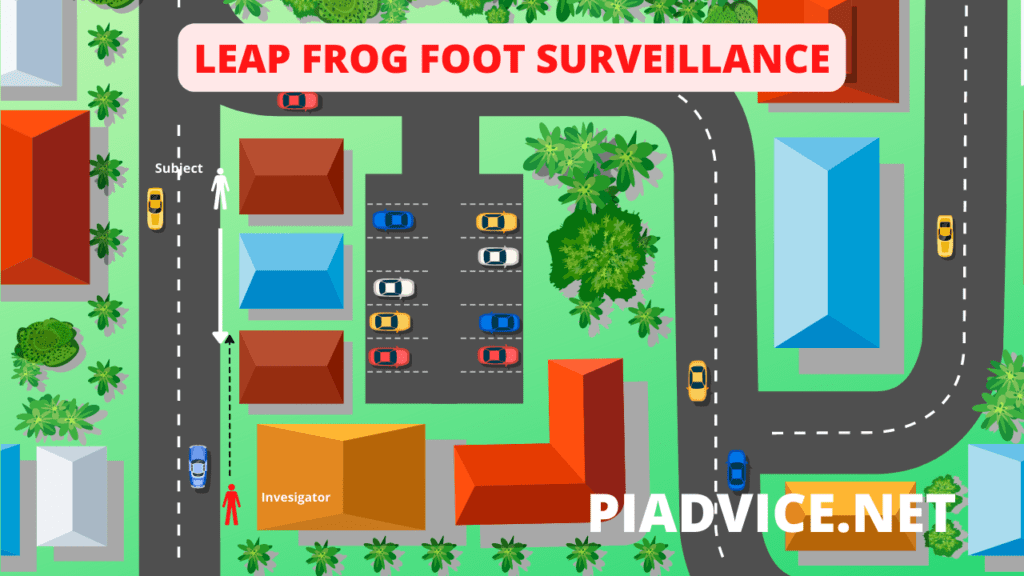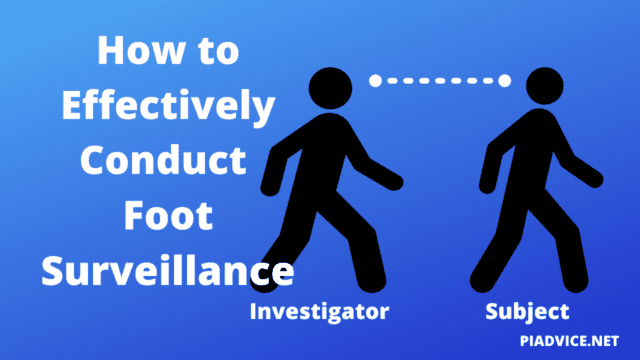There are various types of surveillance that take place by an investigator. The variations of surveillance tactics can evolve throughout the day of surveillance. We will be discussing foot surveillance. So what is foot surveillance and what are good practices when conducting it?
Contents
- 1 What is Foot Surveillance?
- 2 Do You Need a Partner for Foot Surveillance to be Successful?
- 3 When Two Investigators Might Be Needed for a Potential Foot Surveillance
- 4 Using a “Go Bag” When on Foot Surveillance
- 5 Foot Surveillance Basics
- 6 Following a Subject From Behind
- 7 Following a Subject From Across the Street
- 8 Leap Frog a Subject
- 9 Watch Subjects Through Store Windows
- 10 An Investigator Must Limit Their Exposure While on Foot Surveillance
- 11 An Investigator Must Be Prepared to Change Their Appearance
- 12 Foot Surveillance is Important
What is Foot Surveillance?
Foot surveillance is the act of conducting surveillance on someone or something while on foot without a vehicle. Foot surveillance is not the first choice of investigators however in order to conduct surveillance and document subject’s in areas where vehicles can not reach, foot surveillance is the route an investigator will take.
Do You Need a Partner for Foot Surveillance to be Successful?
Private investigators primarily work alone and have to think ahead when mobile surveillance turns into foot surveillance. On many occasions, foot surveillance is straightforward for an investigator.
An example of it being straightforward is when the subject of surveillance travels to a store, parks, and enters the store. The private investigator will park and video the subject as much as possible walking to and entering the store and the investigator will then enter the store.
Another example would be a subject arriving at a beach area with limited parking. The investigator park near the subject as quickly as possible and get on foot so as to not lose the subject.
When Two Investigators Might Be Needed for a Potential Foot Surveillance
Generally speaking, there are times when an investigator will attempt to anticipate an issue knowing foot surveillance will be needed using two investigators. Not all situations are straightforward.
An investigator might attempt to identify a subject or a vehicle a subject drives because a subject is difficult to locate. The investigators will initiate the surveillance at a known appointment that might be in a busy city with many locations to park that aren’t predictable. One investigator will follow the subject from the appointment to identify the subject’s vehicle. The second investigator will attempt to follow the subject from the location while staying in contact with the investigator on foot surveillance.
A second example would be where a subject will be known to be dropped off and the investigator would have no chance of parking and following the subject from the drop-off location. Two investigators would be in the same car. Once the subject would be dropped off, the second investigator would be dropped off as well and initiate foot surveillance. An airport drop-off would be a situation that would align with the situation described.

Using a “Go Bag” When on Foot Surveillance
Are previously stated, some foot surveillance scenarios are cut and dry and are for short durations (subject goes to a grocery store then returns to their vehicle). Simple situations don’t require as much preparation as other foot surveillance situations.
A “Go Bag” is a portable bag that is filled with preparation items for a last-minute situation. A “Go Bag” would include food, water, a surveillance camera, a spy camera, extra batteries, portable power banks, memory cards, a computer, and possibly some change of clothing. This list could be smaller or larger depending on the investigator’s needs.
There are instances where an investigator does not know how long they will be on foot surveillance and where that will lead them. Having backup devices and power available will prevent the investigator from being unable to video document something due to a lack of resources.
Foot Surveillance Basics
Following a Subject From Behind
Foot surveillance may not be as complicated as one might think. One of the foot surveillance basics is to stay behind the subject of an investigation. Most individuals are distracted and looking forward, not behind them. Investigators should keep a healthy distance behind someone but not too far. An investigator can pick out something about the subject that is easy to identify in a crowd in case the area is busy.
If an investigator conducts foot surveillance from behind with too much distance, it can be easy to lose track of them.
If there is no reason to believe a subject is suspicious of the investigator, the investigator should not feel the need to follow a subject from a major distance while following them from behind.

Following a Subject From Across the Street
Another way to not be in the subject’s view would be to conduct foot surveillance from across the street paralleling the subject of your investigation. This is ideal when there is little foot traffic happening in an area.
Not all areas are filled with people mass amounts of people to blend in with. Following a subject from across the street puts less of the investigator in view of the subject. This will be important when following a subject for extended periods of time on foot.

Leap Frog a Subject
Leapfrogging is used in mobile surveillance but it can also be used in foot surveillance. Leapfrogging a subject is good when you believe a subject will be walking in a direction for an extended period of time. An investigator can jump ahead of the subject and videotape them covertly as they walk toward the investigator. Using this tactic will not fit all situations but it can be instrumental in some investigative situations.

Watch Subjects Through Store Windows
In order to break up the time being visually open to the subject, in some situations an investigator can enter a store and watch the subject from within the story without being visible to the subject. This does not fit all situations but can be a temporary tactic.
An Investigator Must Limit Their Exposure While on Foot Surveillance
When conducting foot surveillance a good investigator can not be in the area of the subject at all times. An investigator must spread out the exposure to the subject. The investigator will bring attention to themselves if they enter every store a subject enters or if they follow them down every aisle in a store.
Sometimes an investigator will not enter a location unless it is imperative they do so. Sometimes the investigator will not follow a subject down an aisle.
Investigators can limit their exposure when they believe intermittent views of the subject won’t result in losing the subject.

An Investigator Must Be Prepared to Change Their Appearance
An extra precaution an investigator can take would be to change their appearance if they feel as though there has been too much exposure to the subject of surveillance. Changing appearance might be wearing a hat, or taking a hat off. I could be removing a coat, or putting one on.
The main idea would be to break up the appearance that would detach a subject from remembering something about the investigator.
An investigator should use caution when changing their appearance. They should be careful not to make themselves look more suspicious and memorable than not. Sometimes an investigator’s appearance can draw more attention than diffuse it.
Foot Surveillance is Important
Using foot surveillance can be incredibly important for an investigation. Of course, there are many other types of surveillance and I have written about this in more detail if you would like to read it. Some investigators may dismiss this type of surveillance out of fear or laziness. An investigator must use discernment when choosing not to go on foot to follow a subject.
Obviously, if an investigator can sufficiently follow a subject in a vehicle while the subject is on foot, that would be ideal for remaining covert.
Investigators need to use their best judgment while in the field to be safe but effective while working on a surveillance assignment.

Recent Posts
Hawaii is probably one of the most interesting states to work as a private investigator if you are not used to the culture or a native of the state. And if you are not a local, that is something...
How to become a private investigator in Georgia

